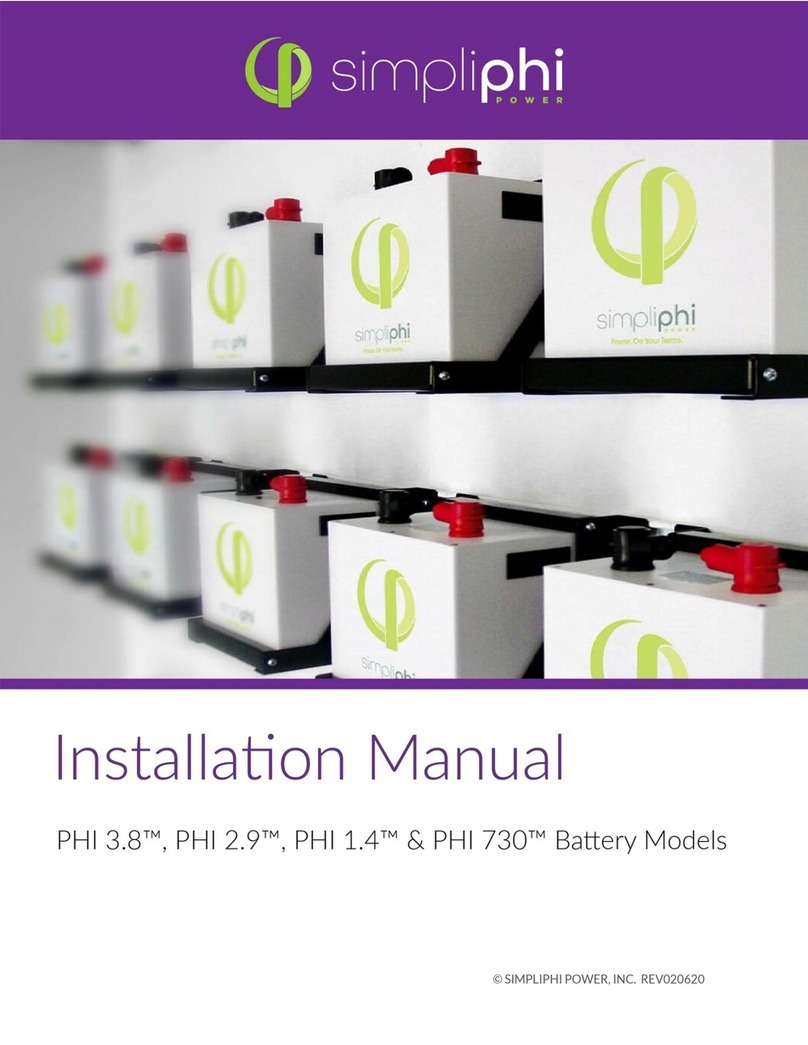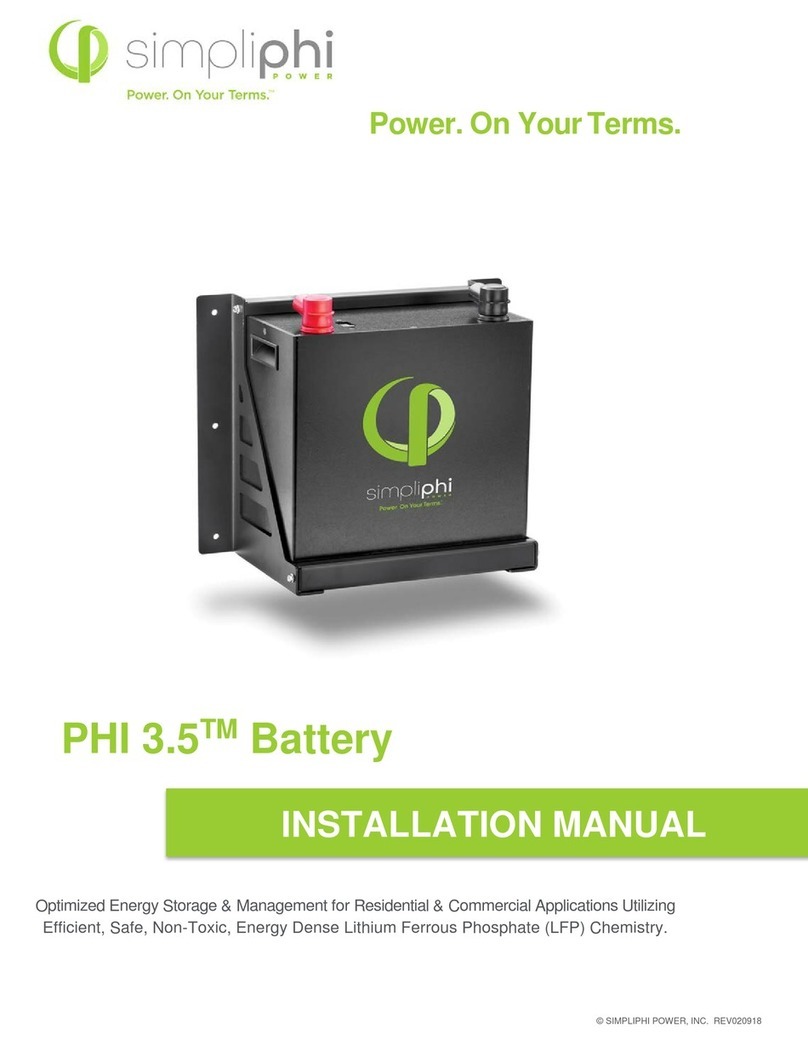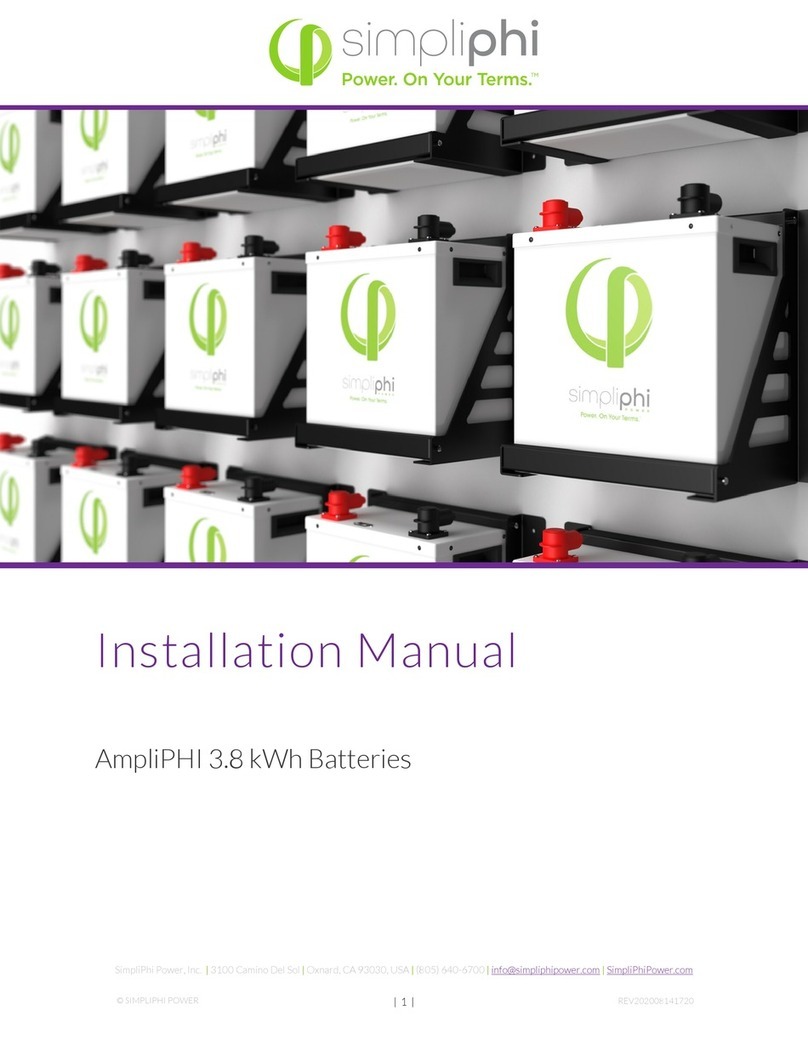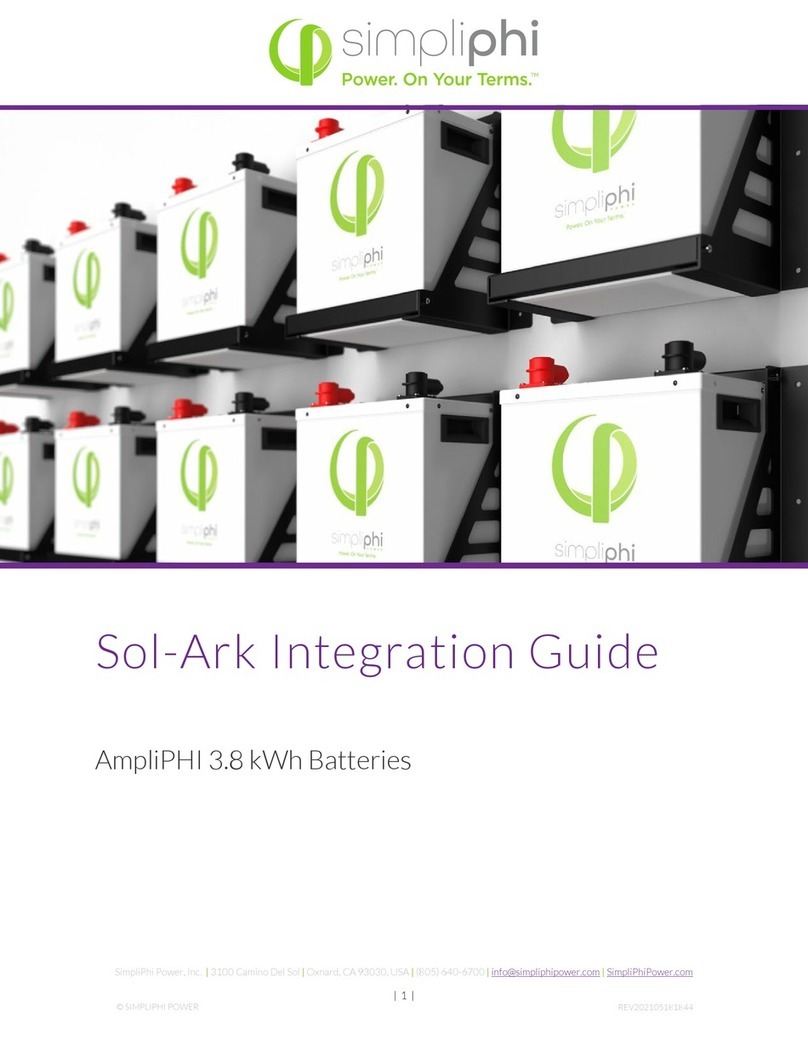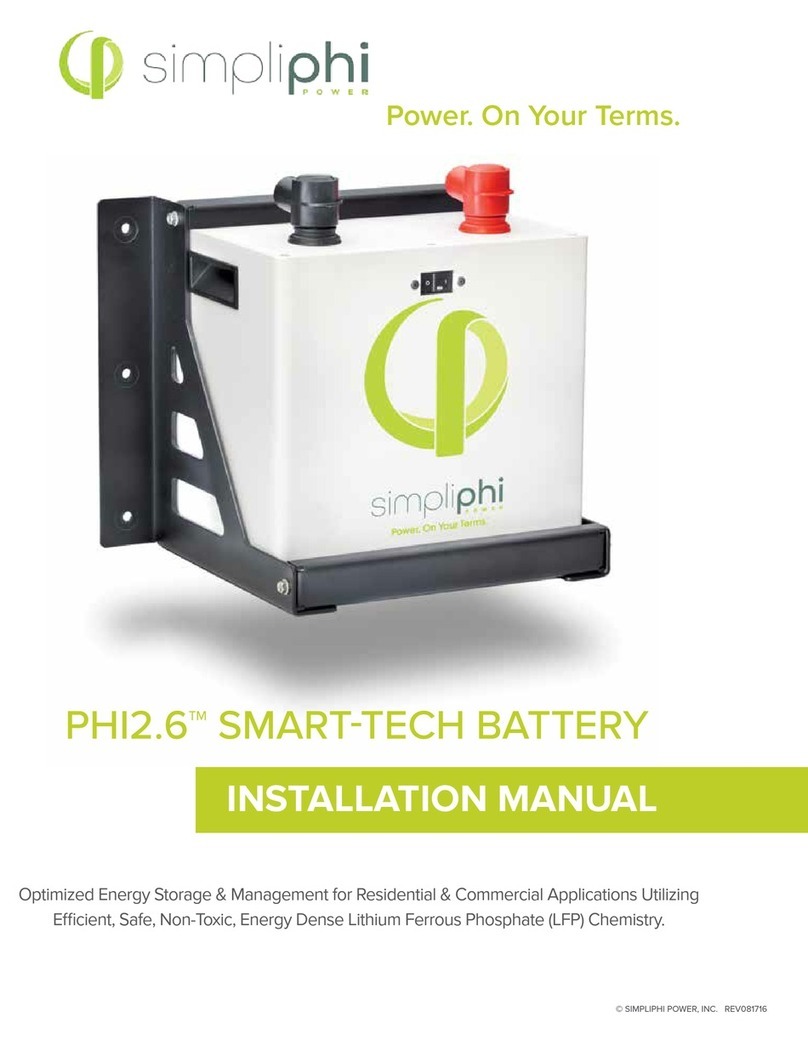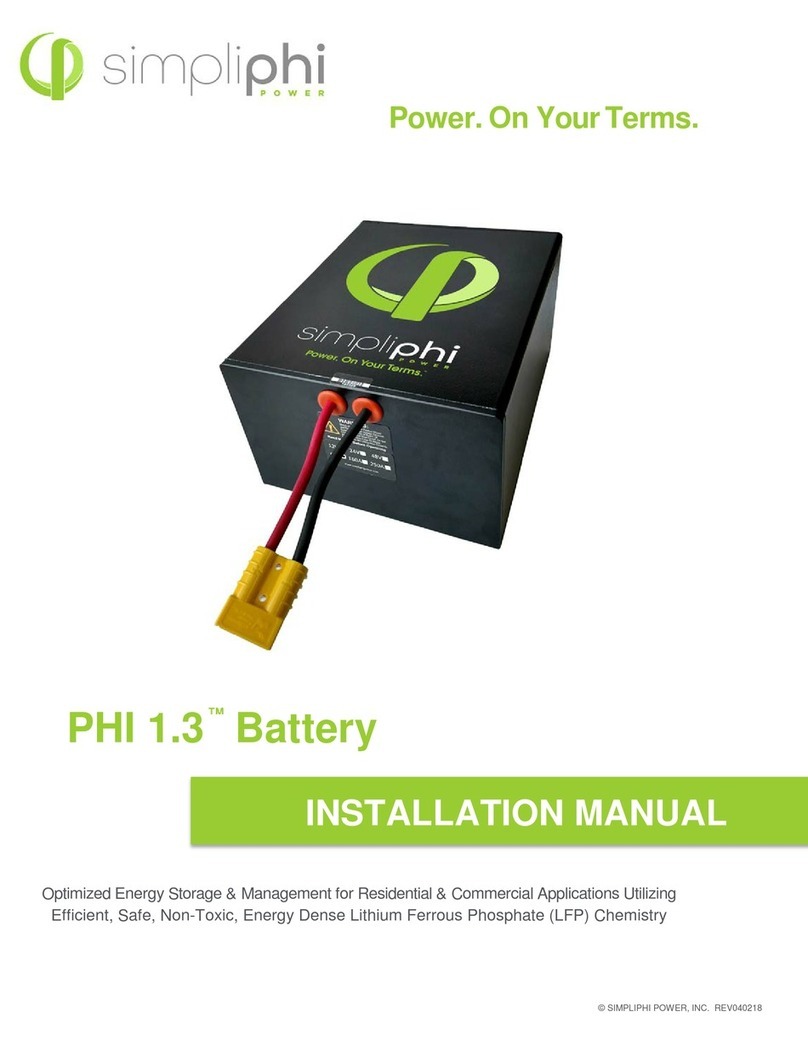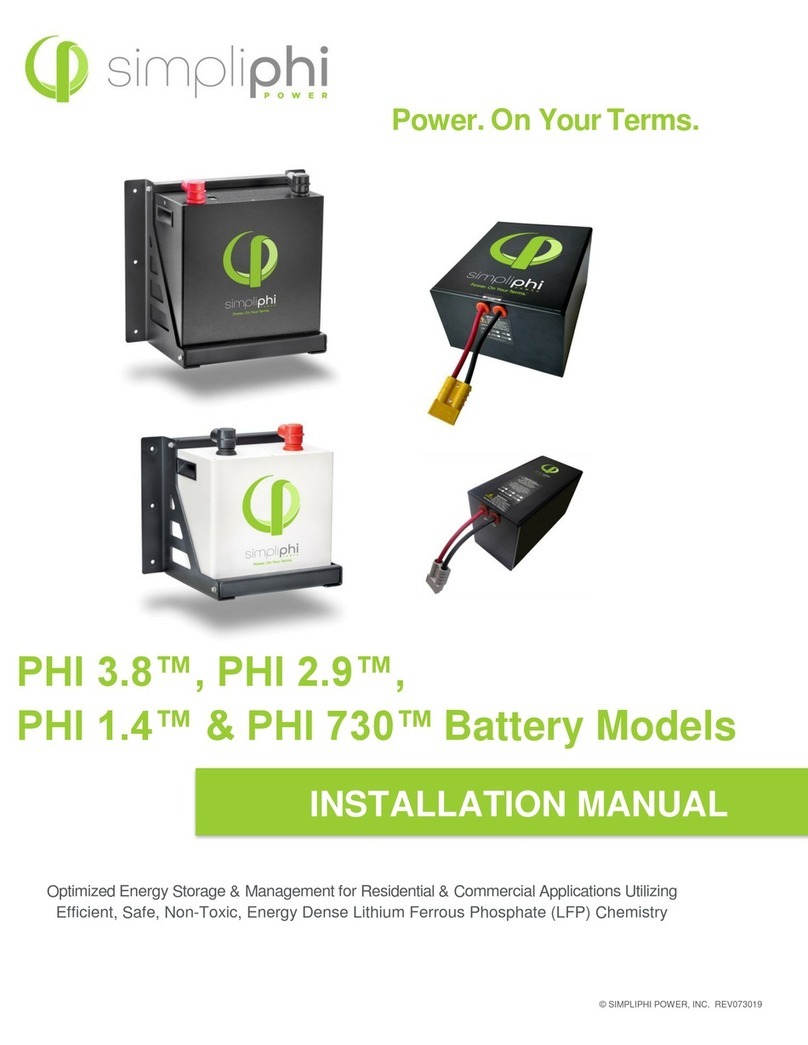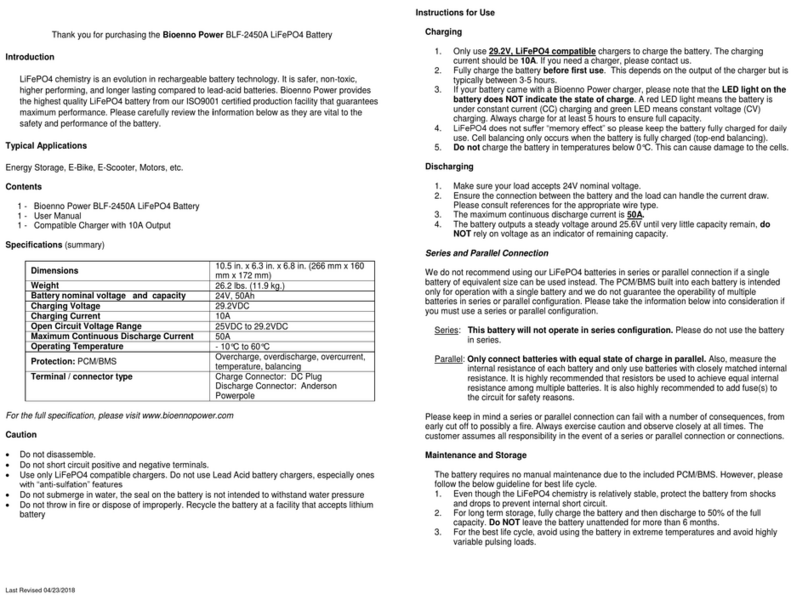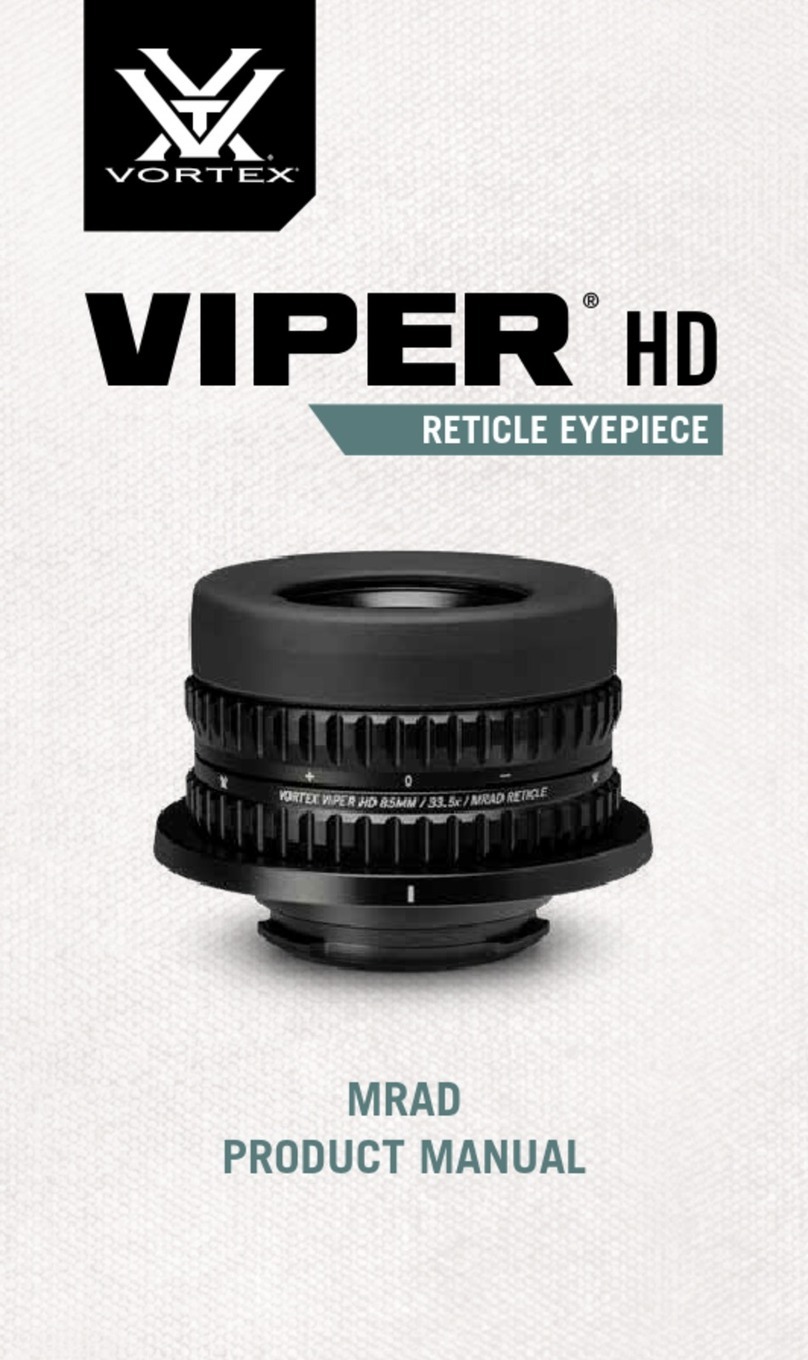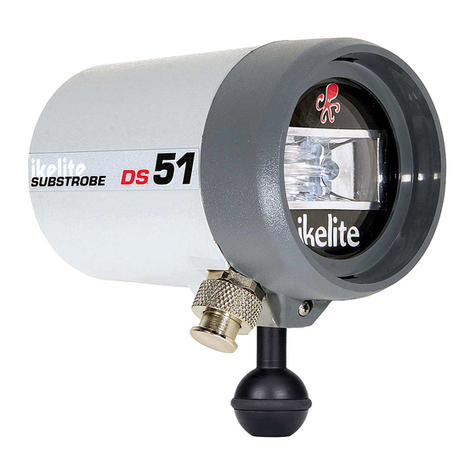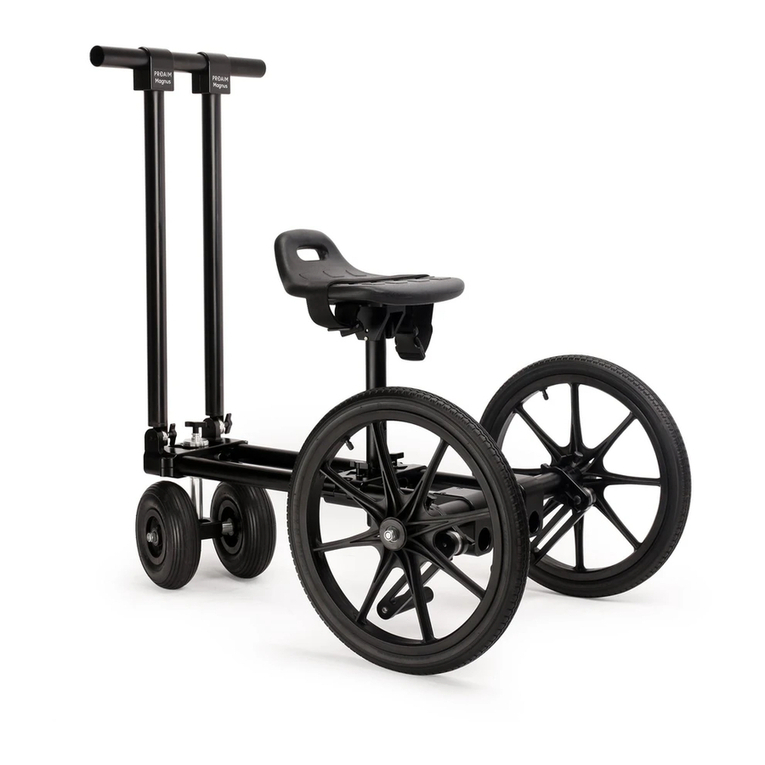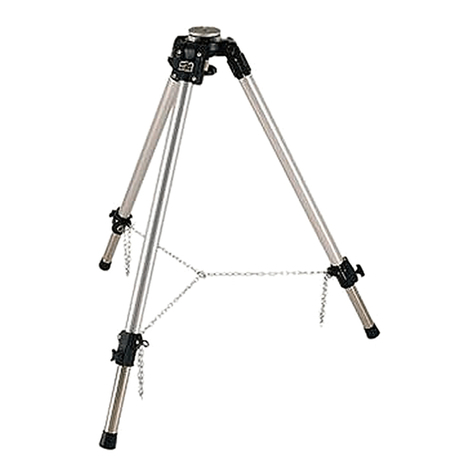SimpliPhi PHI 2.7 User manual

SimpliPhi Power, Inc. | 420 Bryant Circle | Ojai, CA 93023, USA | (805) 640-6700 | info@simpliphipower.com | SimpliPhiPower.com
| 2|
SimpliPhi’s battery technology utilizes the industry’s most
environmentally benign chemistry combined with proprietary
architecture and power electronics (BMS) that eliminate the
need for cooling or ventilation to create products that provide
energy security and resiliency – all with a 98% efficiency rate.
SimpliPhi Your
Energy
Security and
Independence
and gain control of your own power.
SimpliPhi helps you manage your power as a personal resource.
Anytime. Anywhere. SimpliPhi energy storage optimizes
integration of any power generation source – solar, wind,
generator – on or off grid and protects your home and mission-
critical business functions from power outages and intermittency.
SimpliPhi storage technology eliminates operating temperature
constraints, toxic coolants and the risk of thermal runaway and
fire. Safe lithium ferrous phosphate. No cobalt. No hazards.
SimpliPhi Power offers proprietary, commercially available
energy storage
and management systems that
are safe, non-
toxic, reliable, durable, efficient,
highly scalable, and economical over the lifetime of the
PHI 2.7 kWh Battery.

REV0226
18
SimpliPhi Power, Inc. | 420 Bryant Circle | Ojai, CA 93023, USA | (805) 640-6700 | info@simpliphipower.com | SimpliPhiPower.com
| 3|
Table of Contents
1.0 – Important Safety Information ......................................................................................... 4
1.1 – Safety Instructions......................................................................................................... 4
1.2 – Safety & Protective Features......................................................................................... 4
1.3 – Explosive Gas Precautions............................................................................................ 6
2.0 – Product Description........................................................................................................ 7
2.1 – Overview ....................................................................................................................... 7
2.2 – Specifications ................................................................................................................ 7
3.0 – Pre-Installation................................................................................................................ 7
3.1 – PHI 2.7 Battery Performance Parameters and Sizing Calculations................................ 8
3.2 – System Sizing for Your Installation ................................................................................ 8
3.3 – Mounting Hardware ....................................................................................................... 8
3.4 – Battery Weight............................................................................................................... 8
3.5 – Battery Wall Mount + Bracket Dimensions..................................................................... 9
4.0 – Installation & Wiring.......................................................................................................10
4.1 – Basic System Configuration Concepts..........................................................................10
4.2 – Torque Values..............................................................................................................12
4.3 – Battery Wiring Methods.................................................................................................12
5.0 – Programming..................................................................................................................13
5.1 – Operating Parameters per Warranty.............................................................................13
6.0 – SimpliPhi Technical Support.........................................................................................14
Appendix A – Material Safety Data Sheet .................................................................................15
Appendix B – PHI 2.7 Battery Safety & Green Attributes, Certifications....................................17

REV0226
18
SimpliPhi Power, Inc. | 420 Bryant Circle | Ojai, CA 93023, USA | (805) 640-6700 | info@simpliphipower.com | SimpliPhiPower.com
| 4|
1.0 – Important Safety Information
1.1 – Safety Instructions
1. Before using the PHI 2.7 Batteries, read all instructions and cautionary markings on the PHI 2.7
Batteries, and all appropriate sections of this manual.
2. PHI 2.7 Batteries must be fully charged before commissioning. Failure to do so will void the
Warranty.
3. Use of accessories not recommended or sold by the manufacturer may result in a risk of fire, electric
shock, or injury to persons and will void the Warranty.
4. Verify system settings are in compliance with the PHI 2.7 Battery Warranty and this PHI 2.7 Battery
Installation Manual (which take precedence). Violating Warranty conditions specified in these
documents will void the Warranty on the PHI 2.7 Batteries.
5. Consult the Integration Guide for Inverter Charge Controller programming settings for relevant
warnings and notices. Violating Warranty conditions specified in those Inverter Integration Guides
will void the Warranty on the PHI 2.7 Batteries, not just the inverter equipment. Consult SimpliPhi
Power technical support regarding any inconstancies with other referenced documents.
6. Although each PHI 2.7 Battery contains both a circuit breaker and an internal BMS with circuitry that
protects the PHI 2.7 Battery cells from overcharge, over-discharge and extreme load amperage, the
PHI 2.7 Batteries must always be installed with appropriate inverter charge controller settings and
power electronics to protect the PHI 2.7 from open PV voltage and other high voltage charging
sources. Do not attempt to replace existing power electronics without SimpliPhi’s written approval.
Failure to adhere to installation protocol will void the Warranty.
7. Verify polarity at all connections with a standard volt meter before 1) energizing the system and 2)
turning the PHI 2.7 circuit breaker “ON/OFF” switch to the “ON” position. Reverse polarity at the PHI
2.7 Battery terminals will void the Warranty and destroy the PHI 2.7 Batteries.
8. PHI 2.7 Batteries pose some risk of shock or sparking during the installation and initial wiring and
connection process. This is consistent with all other battery-based storage formats. Be sure to turn
the built-in circuit breaker to the “OFF” position to minimize the risk of shock or sparks during the
installation and commissioning of the system.
9. To avoid a risk of fire and electric shock, make sure that existing wiring is in good condition and that
wire is not undersized. Do not operate the unit with damaged or substandard wiring.
10. Do not operate if the PHI 2.7 Battery has been damaged in any way during shipping or otherwise.
11. Only use a SimpliPhi approved LFP battery charger if ancillary charging is required before
installation, testing or troubleshooting. Failure to use a SimpliPhi approved LFP battery charger will
damage the PHI 2.7 Battery and void the Warranty.
12. To reduce the chance of short-circuits, always use insulated tools when installing or working with this
equipment.
13. Remove personal metal items such as rings, bracelets, necklaces, and watches when working with
electrical equipment.
1.2 – Safety & Protective Features
1.2.1 – 80A Breaker
All PHI 2.7 Batteries are outfitted with an 80A hydraulic/magnetic circuit breaker. This breaker
increases safety during shipping and installations and allows the PHI 2.7 Battery to effectively be
turned “OFF” or “ON.” The breaker works in conjunction with the built-in battery management
system (BMS) and creates additional safety, efficiency and functionality to the overall power
storage system.

REV0226
18
SimpliPhi Power, Inc. | 420 Bryant Circle | Ojai, CA 93023, USA | (805) 640-6700 | info@simpliphipower.com | SimpliPhiPower.com
| 5|
Figure 1.0 - PHI 2.7 kWh 48V Circuit Breaker
CAUTION: Circuit Breakers, Disconnects and Fuses should be employed throughout several
points of a power storage and generation installation to effectively isolate and protect all
components of the system to safeguard against faults, short circuits, polarity reversals or a failure
of any component in the overall system. Fuses, breakers, wiring ratings and values should be
determined by established standards and evaluated by certified electricians, licensed installers,
and regional code authorities. Although each PHI 2.7 Battery contains both a circuit breaker and
an internal BMS with circuitry that protects the Lithium Ferrous Phosphate cells from overcharge,
over-discharge and extreme load amperage, the PHI 2.7 Batteries must always be installed with a
charge controller and the appropriate settings to protect the PHI 2.7 Battery from open PV voltage
and other high voltage charging sources. The PHI 2.7 Battery Management System (BMS) and
internal circuit breaker alone will not protect the PHI 2.7 Batteries from these extreme electrical
phenomena. Failure to adhere to installation protocol will void the Warranty.
CAUTION: Verify polarity at all connections with a standard volt meter before 1) energizing the
system and 2) turning the PHI 2.7 circuit breaker “ON/OFF” switch to the “ON” position. Reverse
polarity at the battery terminals will void the Warranty and destroy the PHI 2.7 Batteries.
PHI 2.7 Batteries pose some risk of shock or sparking during the installation and initial wiring and
connection process. This is consistent with all other battery-based storage formats. Be sure to
turn the built-in breaker to the “OFF” position to minimalize the risk of shock or sparks during the
installation and commissioning of the system. Use of insulated gloves, clothing and footwear is
always recommended when working in close proximity to electrical devices. Cover, restrain or
remove jewelry or conductive objects (metal bracelets, rings, belt buckles, metal snaps, zippers,
etc.) when working with any electrical or mechanical device. Cover or restrain long hair and loose
clothing when working with any electrical or mechanical device.
PHI 2.7 Batteries do not vent any harmful gasses, and do not require special ventilation or cooling.
PHI 2.7 Batteries are not capable of thermal runaway. If the cells are severely damaged due to
physical abuse incurred outside of warranted specifications, which can cause electrolyte leakage
and other failures, as with any PHI 2.7 Battery, the electrolyte can be ignited by an open flame.
However, unlike other lithium ion batteries (LCO) there are no hazardous or toxic materials in the
electrolyte or the material components of PHI 2.7 Batteries. See MSDS for chemical analyses
(Appendix A).

REV0226
18
SimpliPhi Power, Inc. | 420 Bryant Circle | Ojai, CA 93023, USA | (805) 640-6700 | info@simpliphipower.com | SimpliPhiPower.com
| 6|
1.2.2 – Charging at Temperatures Below Freezing
It is important to take necessary steps to determine the temperature of the PHI 2.7 Battery prior to
charging the battery, as the battery may otherwise be adversely impacted.
CAUTION:Do not attempt to charge the PHI 2.7 Battery below 32°F (0° C). Although cold
temperatures do not harm PHI 2.7 Batteries, attempts to charge at subfreezing temperatures can
adversely affect SOH and cycle life, and will void the Warranty. If the PHI 2.7 Battery must be
charged below 32° F (0° C), the rate of charge must be at no more than 5% of the PHI 2.7
Battery’s rated capacity (C/20).
CAUTION:Only use a SimpliPhi approved LFP charger if ancillary charging is required before
installation, testing or troubleshooting. Failure to use a SimpliPhi approved LFP charger will damage
the PHI 2.7 Battery and void the Warranty.
1.2.3 – Battery Management System (BMS)
PHI 2.7 Batteries are manufactured utilizing Lithium Ferrous Phosphate (LFP) cells, which are
produced under exclusive patented licensed technologies, as well as proprietary materials,
architecture, assembly methods and battery management system (BMS). This assures the
highest grade and quality, longest cycle-life, greatest efficiency and freedom from material
impurities, toxicity and hazardous risk.
Each PHI 2.7 Battery contains circuitry that protects the Lithium Ferrous Phosphate cells from
overcharge, over-discharge and extreme load amperage. If the values specified are exceeded,
the protective circuitry will shut down the flow of electricity to/from the PHI 2.7 Batteries. In some
cases, this will result in the need to re-initialize an inverter charger. Often, inverter system
settings will be saved within the inverter memory storage and will not need to be reset. This is not
an absolute standard but is common amongst most inverter chargers and should be anticipated if
the PHI 2.7 Batteries go into a state of self-protection and shut down the flow of electricity. Refer
to SimpliPhi’s inverter integration guides for inverter charge controller settings or contract the
inverter manufacturer directly.
1.2.4 – PHI 2.7 Battery Connection Terminals
The PHI 2.7 Batteries are equipped with two 3/8’’ threaded studs with a lock washer and nut. The
red colored high temperature molded insert connection is for the positive lead. The black colored
high temperature insert connection is for the negative lead.
CAUTION: Do not attempt to loosen the large brass nut at the base of the terminals.
CAUTION: Do not reverse polarity. It will void the Warranty. Use a volt meter to check polarity before
connecting terminals.
Water Resistant Cable Boots are also included and will be in place when your units arrive. The
boots are to be placed over the cable terminations and will stretch to form a water-resistant seal
around the base of the molded inserts and terminal connections.
1.3 – Explosive Gas Precautions
This equipment is not ignition protected. To prevent fire or explosion, do not install this product in
locations that require ignition-protected equipment. This includes any confined space containing vented
batteries, or flammable chemicals such as, natural gas (NG), liquid petroleum gas (LPG) or gasoline
(Benzine/Petrol).

REV0226
18
SimpliPhi Power, Inc. | 420 Bryant Circle | Ojai, CA 93023, USA | (805) 640-6700 | info@simpliphipower.com | SimpliPhiPower.com
| 7|
Do not install in a confined space with machinery powered by flammable chemicals, or storage tanks,
fittings, or other connections between components of fuel or flammable chemical systems.
2.0 – Product Description
2.1 – Overview
The PHI 2.7 kWh 60 Amp deep-cycle Lithium Ferro Phosphate (LFP) Battery is optimized with proprietary
cell architecture, power electronics, BMS and assembly methods. It is modular, light-weight and scalable.
The PHI 2.7 Battery provides power security and seamless integration of renewable and traditional
sources of energy in conjunction with or independent of the grid: net zero, peak shaving, emergency
back-up, portable and mobile.
2.2 – Specifications
Please review Table 1.0 below for PHI 2.7 Battery specifications, including physical dimensions, Warranty
period, and technical data.
Table 1.0 - PHI 2.7 Battery Specifications
Notes:
•1. Max operating conditions. Refer to Programming section.
•Specifications are typical/nominal. Subject to change without notice.
•There is less than 1% loss of energy during charging.
3.0 – Pre-Installation
The information within this section covers pre-installation procedures & considerations, namely, PHI 2.7
Battery performance parameters to be aware of during the design process, guidance on system sizing, as
well as mounting hardware and PHI 2.7 Battery weight.

REV0226
18
SimpliPhi Power, Inc. | 420 Bryant Circle | Ojai, CA 93023, USA | (805) 640-6700 | info@simpliphipower.com | SimpliPhiPower.com
| 8|
3.1 – PHI 2.7 Battery Performance Parameters and Sizing
Calculations
PHI 2.7 Batteries are designed to operate at a continuous C/2 rate across a large operating temperature
range, as seen in Table 1.0 above. The PHI 2.7 Batteries need no increase in sizing and no special
compensations when determining the size of the energy storage and management system under the
circumstances and conditions seen in Table 1.0 above. See specific inverter manufacturer program
settings for optimizing system integration.
PHI 2.7 Batteries do not need to be de-rated unless running continuously at more than 90% capacity, at
temperatures below 0 degrees Celsius, or above 49 degrees Celsius. To achieve higher, warrantied cycles
of 10,000+, the PHI 2.7 Batteries are typically operated at 80% maximum Depth of Discharge. Please
contact SimpliPhi Power Technical Support if alternative settings are desired. Please also refer to operating
temperatures and inverter settings in Programming section.
3.2 – System Sizing for Your Installation
The number of PHI 2.7 Batteries should be specified in terms of total storage capacity before the initial
installation based on the goals and objectives of the project. All PHI 2.7 Batteries are balanced during
final production and testing stages. Following proper wiring guidelines ensures that a system will not
require any manual balancing processes.
CAUTION: Do not combine PHI 2.7 Batteries with other brands or chemistries. This will void the Warranty.
CAUTION: Do not mix PHI 2.7 Batteries from different installations, clients or job sites. This will void the
Warranty.
3.3 – Mounting Hardware
The SimpliPhi Power Mounting Brackets (sold separately) are designed to secure one PHI 2.7 Battery to
a load bearing surface. SimpliPhi Power PHI 2.7 Batteries can be mounted in practically any orientation
(terminals up or on any side), with no impact to the performance of the PHI 2.7 Battery. Do not install
them upside down. The brackets can be mounted directly to a wall or can be arranged on strut channels
for ease of positioning (mounting hardware not included). A qualified installer should be familiar with
accomplishing this with the appropriate load bearing requirements.
For ease of measuring, arranging and mounting your PHI 2.7 Battery array, a drawing of the PHI 2.7
Battery Mounting Brackets with dimensions is provided (Figure 2.0).
During mechanical testing, individual PHI 2.7 Mounting Brackets were exposed to 200 pounds each of
downward pressure along the bracket’s outer edge. During this test, a deflection of approximately 30
thousandths of an inch was measured. Bracket sets are designed to hold one PHI 2.7 Module, with a
weight of ~60 pounds.
3.4 – Battery Weight
PHI 2.7 Batteries weigh 60.5 pounds. The Wall Mount Bracket Assemblies weigh 9 Pounds (with bolts).
The SimpliPhi Power Mounting Brackets should be mounted into load bearing beams, studs or solid
materials with appropriate fasteners. SimpliPhi Power is not liable for damage caused by inappropriate
installation mounting of brackets.

REV0226
18
SimpliPhi Power, Inc. | 420 Bryant Circle | Ojai, CA 93023, USA | (805) 640-6700 | info@simpliphipower.com | SimpliPhiPower.com
| 9|
3.5 – Battery Wall Mount + Bracket Dimensions
Please see the table below for physical dimensions of the PHI 2.7 Battery both with, and without, the
SimpliPhi Power Mounting Bracket, as well as a diagram that provides guidance on Mounting Bracket
assembly.
Table 2.0 – Specifications: PHI 2.7 Battery v. PHI 2.7 Battery w/ Mounting Bracket
PHI 2.7 Battery
PHI 2.7 Battery
w/ Mounting Bracket
Width 11.25’’ 13.7” (15.5” with mounting flanges)
Height 12.75" (including 1.75” terminal height)13” (including 1.75” terminal height)
Depth 9.5”10.5”
Weight 60.5 Pounds 69.5 pounds
Figure 2.0 – Mounting Bracket Assembly

REV0226
18
SimpliPhi Power, Inc. | 420 Bryant Circle | Ojai, CA 93023, USA | (805) 640-6700 | info@simpliphipower.com | SimpliPhiPower.com
| 10 |
4.0 – Installation & Wiring
This section covers basic concepts of system configuration as well as how to increase storage capacity
by wiring in parallel.
4.1 – Basic System Configuration Concepts
Safe and reliable installation requires trained and certified technicians. The following discussion of PHI 2.7
Battery configurations is a basic primer. Due to the variety of systems and components in the field, all
possible scenarios are not covered. This is not the purpose of this section of the manual. Refer to
professional installers regarding your system and its components and specifications. We encourage you or
your installer to contact us with any specific questions for technical support. We are committed to working
with you and your installation team to achieve a safe, reliable storage system that will provide years of
maintenance free service.
4.1.1 – System Wiring Basics
Refer to published electrical wiring specifications and ratings. All wire should be an appropriate
gauge and construction to handle the loads that will be placed upon it. Heavy gauge, high strand
copper wire is the industry standard due to its stability, efficiency and overall quality. A qualified
installer should understand this and must adhere to the industry standard and published electrical
guidelines.
For all installations:
•Maintain identical wire lengths from each PHI 2.7 Battery terminal to the common bus.
•Use identical wire construction from each PHI 2.7 Battery terminal to the common bus.
All PHI 2.7 Batteries are designed to serve at a fixed voltage range in parallel arrangements for
maximum available amperage and storage capacity. PHI 2.7 Batteries are not designed to be
arranged in series for increased voltage. Series arrangements can result in damage to the PHI
2.7 Battery’s protective circuitry and will void the Warranty.
4.1.2 – Increasing Storage Capacity & Simple Parallel
Arrangements
Storage Capacity and total available Amperage is increased incrementally with the number of
units in Parallel arrangements. The following illustration shows two PHI 2.7 Batteries in Parallel.
For example, assume that these are 24V Batteries.
Note:The overall Voltage range is not changed. The arrangement remains at 24 Volts, the
available AH capacity (ability to provide 24 Volt power over time) has also been doubled with the
addition of a second PHI 2.7 Battery. The available amperage from the system has been doubled.
The same configuration should be applied to other parallel arrangements, whether they are 24V
or 48V. See Figure 4.0.
CAUTION: PHI 2.7 Batteries are designed for parallel operation only. Do not arrange in series for
increased voltage. Wiring in series will void Warranty.

REV0226
18
SimpliPhi Power, Inc. | 420 Bryant Circle | Ojai, CA 93023, USA | (805) 640-6700 | info@simpliphipower.com | SimpliPhiPower.com
| 11 |
Figure 3.0 – Two PHI 2.7 Batteries in Parallel
Figure 3.0 represents two PHI 2.7 Batteries in Parallel. Wire lengths from PHI 2.7 Batteries
should be identical in length and gauge in order to balance the load across (all) PHI 2.7 Batteries
in the installation. Identical wiring length is a critical feature of parallel power storage
systems that must be adhered to throughout all parallel wiring instructions.
Special attention should be paid for parallel installations. Correct wiring is essential to insure
optimum performance and system longevity. All wire “runs” should utilize identical wiring gauge
and identical wire lengths between PHI 2.7 Batteries and the common negative or positive
“Bus” or Load. Figure 4.0 depicts four PHI 2.7 Batteries that have been wired in Parallel. This
configuration requires 8 identical lengths of appropriately heavy gauge copper wire.
Figure 4.0 - Four PHI 2.7 Batteries in Parallel
Helpful Tips:
•Use identical length and gauge wire to balance the load across the PHI 2.7 Batteries.
•Determine the cable length for the PHI 2.7 Battery terminal farthest from the bus.
•Make all PHI 2.7 Battery cables a matching length.

REV0226
18
SimpliPhi Power, Inc. | 420 Bryant Circle | Ojai, CA 93023, USA | (805) 640-6700 | info@simpliphipower.com | SimpliPhiPower.com
| 12 |
•Additional cabling or slack that remains with the shorter distance runs can be coiled
and secured with Zip Ties.
Wiring Methods:
1. For 1 to 8 units: Wire directly to inverter & charge controller equipment.
2. For 6 to 20 units: Use a DC combiner or panelboard.
3. For 20+ units: Connect the PHI 2.7 Battery terminals directly to a common bus.
4.2 – Torque Values
For the DC terminals on the PHI 2.7 Battery, torque to 160 in-lb (13.3 ft-lb).
4.3 – Battery Wiring Methods
4.3.1 – Connecting Cable Leads to the PHI 2.7 Batteries
Before connecting the cable leads to the PHI 2.7 Battery, please be aware of the following
information concerning power cabling, considerations for power cable terminations as well as
installation environments.
CAUTION: Spark may be present when connecting wires to PHI 2.7 terminals.
CAUTION: Do not reverse polarity. It will void the Warranty. Use a volt meter to check polarity before
connecting terminals. A brief small spark is often present when connecting the second of two leads
to a PHI 2.7 Battery. Example: If the Positive has been connected, a small spark will likely be
present when connecting the Negative lead. This is a normal occurrence. Complete all
connections in a clean, ventilated, well-lit area. To avoid any spark or electrical event when
connecting the terminal leads on the PHI 2.7 Battery, turn the circuit breaker “ON/OFF” switch to
“OFF” position.
Power Cabling for the PHI 2.7 Battery is not included. Your qualified installer or application
specifications will determine the wire gauge for your system. Connection to the PHI 2.7 Battery
terminal should only be made using appropriately sized ring terminals for your PHI 2.7 Battery
cables.
High amperage rated ring terminals can be found for these and other common wire gauges. Your
installer can source these.
Considerations for Power Cable Terminations
Please factor in the below information for power cable terminations:
•PHI 2.7 Battery Mounting Stud Size: 3/8’’
•Power Cable Wire Gauge: Generally, anywhere from 6 AWG to 2/0 AWG or larger
Protection from the Environment
Anticorrosive compounds or epoxies are occasionally used in harsh or marine climate
installations. Please contact your Electrician or Qualified Installer to determine if this is advisable,
and if so, what solution best suits your application.
4.3.2 – Final Connection of the Installation
Final installation and operation guidelines will be dictated by your Electrician and Installer based
on the overall properties of and procedures for the equipment in your installation and any code
requirements that apply to your region. SimpliPhi Power, Inc. technicians and sales staff are
available to provide any additional information on the PHI 2.7 Battery as needed. Please contact
SimpliPhi Power for any technical support at your convenience. SimpliPhi Power, Inc. is
committed to providing safe, reliable energy storage and management that is maintenance free,
non-toxic and long-lasting. This commitment extends to our customers, valued installers,

REV0226
18
SimpliPhi Power, Inc. | 420 Bryant Circle | Ojai, CA 93023, USA | (805) 640-6700 | info@simpliphipower.com | SimpliPhiPower.com
| 13 |
partners, and to the community at large. Please be aware of the potential electrical hazards
before interacting with any and all electrical or mechanical devices. Please take all necessary
precautions in your projects and installations. Please refer to Section 1 for safety guidelines.
PHI 2.7 Batteries feature a Low Battery Voltage Cut Off (LBCO). This is a self-protection
mechanism that prevents over discharge. The LBCO will cause the PHI 2.7 Battery to turn off
once batteries approach Zero Capacity or 100% Depth of Discharge.
Most, if not all, inverters have related features. These features are often referred to as “Load
Disconnect”, “Load Shedding” or similar. These features are there to protect the PHI 2.7 Battery
bank from excessive discharge. In instances of low battery voltage, when there is no incoming
energy to recharge the PHI 2.7 Battery bank, the inverter will disconnect the load and remain in
standby until the PHI 2.7 Battery bank is recharged.
For off grid installations, where charge energy is only provided by renewable energy such as PV
arrays, Inverter “Load Disconnects” are generally set at a value that will allow a system to remain
online and in standby for at least 24 hours (10% at top of charge and 10% at bottom of charge).
This allows a system to stay online until at least one full day of sun can recharge the PHI 2.7
Battery bank.
In any application, off-grid or grid-tied, if your PHI 2.7 Battery bank is reaching the LBCO, load
disconnects or load shedding set points may need to be adjusted. Refer to Programming section.
In case of LBCO, cycle the DC Battery Disconnect (inverter), in order to reset the system. Only
complete this procedure when there is a charge source available, otherwise, the system will
simply reach LBCO in a short time period and shut down again.
5.0 – Programming
5.1 – Operating Parameters per Warranty
Although the PHI 2.7 Batteries are capable of performing at very high rates and depths of discharge
within a very wide temperature range, in order to achieve extended life cycles and to comply with the
Warranty, the operating parameters, indicated in Tables 3.0 and 4.0 below, must be adhered to.
Table 3.0 – Warranty Operation Parameters
Recommended Operating Conditions for 10 Year Warranty
Equivalent to 80% Retained Capacity
10,000 cycles
5,000 cycles
3,500 cycles
Discharge/Charge Rate1,2
C/2
DoD4
80%
90%
100%
Operating Temperature °F (°C)
32 to 110 (0 to 43)
32 to 120 (0 to 49)
32 to 120 (0 to 49)
Programming Settings for Ancillary
Equipment
24V
48V
24V
48V
24V
48V
Absorb / High Cut-Off Voltage (V)3
28
56
28.8
57.6
28.8
57.6
Recharge / Low Cut-Off Voltage (V)3
25.1
50.2
24.8
49.6
24
48

REV0226
18
SimpliPhi Power, Inc. | 420 Bryant Circle | Ojai, CA 93023, USA | (805) 640-6700 | info@simpliphipower.com | SimpliPhiPower.com
| 14 |
Table 4.0 – Operating Limitations
Notes / Operating Limitations for
PHI 2.7 Batteries
1 Limitations by Model
24V 48V
Continuous Discharge Rate (A)
45 26
Continuous Charge Rate (A)
45 26
2 60A Discharge/Charge Rate (10 minutes maximum)
3 Levels are typically @ 25°C and may need adjusting at temperature extremes.
4 When performing rapid deep charge/discharge cycles, the PHI 2.7 Battery should be
allowed to "rest" 15 mins in between.
CAUTION: Verify polarity at all connections before energizing system. Reverse polarity at the PHI 2.7 Battery
terminals will void the Warranty and destroy the PHI 2.7 Batteries.
CAUTION: Before commissioning the system, the appropriate controller and inverter settings must be
programmed per the manufacturer’s recommendations. Consult the manufacturer’s manuals and/or
access technical support (Schneider, SMA, Magnum, Outback, etc.). The following Charge Controller
Integration tables are for general reference only.
CAUTION: All SimpliPhi Power products are designed to work exclusively in parallel. Never connect in
series to achieve higher voltages.
6.0 – SimpliPhi Technical Support
For technical support related to your PHI 2.7 Battery, please contact us as follows:
805.640.1874

REV0226
18
SimpliPhi Power, Inc. | 420 Bryant Circle | Ojai, CA 93023, USA | (805) 640-6700 | info@simpliphipower.com | SimpliPhiPower.com
| 15 |
Appendix A – Material Safety Data Sheet
A.1 – Product Identification
Product Name: Electronically Managed Energy Storage Device (Battery)
Models: PHI 2.7, PHI 3.5
Product Use: Electric Power Supply - Harmony Code #8504.40.9540, Foreign Trade Schedule B
Manufacturer: SimpliPhi Power, Inc., Ojai Ca. U.S.A. 805 640 6700
A.2 – Composition and Ingredient Information
Under normal use, the PHI 2.7 Battery does not expose the user to hazardous ingredients.
USA: The PHI 2.7 Battery is an article pursuant to 29 CFR 1910.1200 and, as such, is not subject to the
OSHA Hazard Communication Standard Requirement.
The information contained in this Material Safety Data Sheet contains valuable information critical to the
safe handling and proper use of the product. This MSDS should be retained and available for employees
and other users of this product.
Canada: This is not a controlled product under WHMIS. This product meets the definition of a
“Manufactured Article” and is not subject to the regulations of the Hazardous Products Act.
A.3 – Hazards Identification Table 5.0
Common Chemical Name CAS # Percent of
Content (%) Classification &
Hazard Labeling
Lithium Ferrous Phosphate (LiFePo4)
15365-14-7
25-35
Eye, Skin, Respiratory
Irritant
Carbon, as Graphite
7440-44-0
12-18
Eye, Skin, Respiratory
Irritant
Aluminum Metal
7429-90-5
3-7
Inert
Copper Metal
7440-50-8
5-9
Inert
Electrolyte
12-17
Mixture:
Ethylene Carbonate
96-49-1
Flammable; Reactive;
Sensitizer
Dimethyl Carbonate
616-38-6
Eye, Skin, Respiratory
Irritant
Ethyl Methyl Carbonate
623-53-0
Lithium Hexafluorophosphate
21324-40-3
Preparation Hazards and Classification: Not dangerous with normal use. The PHI 2.7 Battery should
not be disassembled or incinerated. Exposure to the ingredients contained within or their combustion
products could be harmful. Appearance, Color, and Odor: Solid object, no odor.
Primary Route(s) of Exposure: Risk of exposure will only occur if the PHI 2.7 Battery or cell is
mechanically, thermally or electrically abused and the enclosure is compromised. If this occurs, exposure
to electrolyte solutions contained within the PHI 2.7 Battery or cell may occur by inhalation, eye contact,
skin contact and ingestion.

REV0226
18
SimpliPhi Power, Inc. | 420 Bryant Circle | Ojai, CA 93023, USA | (805) 640-6700 | info@simpliphipower.com | SimpliPhiPower.com
| 16 |
Potential Health Effects:
Inhalation: Inhalation of material from a sealed PHI 2.7 Battery is not an expected route of exposure.
Vapors or mists from a ruptured PHI 2.7 Battery may cause respiratory irritation.
Ingestion: Swallowing of material from a sealed PHI 2.7 Battery is not an expected route of exposure.
Swallowing mists from a ruptured PHI 2.7 Battery may cause respiratory irritation, chemical burns of the
mouth and gastrointestinal tract irritation.
Skin: Contact between the PHI 2.7 Battery and skin will not cause any harm. Skin contact with positive
and negative terminals of high voltages may cause burns to the skin. Skin contact with a ruptured PHI 2.7
Battery can cause skin irritation.
Eye: Contact between the PHI 2.7 Battery and eye will not cause any harm. Eye contact with the contents
of a ruptured PHI 2.7 Battery can cause severe irritation to the eye. Medical Conditions Aggravated by
Exposure: Not Available
A.4 – First Aid Measures
Skin Contact: Wash affected area with lukewarm water for at least 30 minutes. If irritation or pain
persists, seek medical attention.
Eye Contact: Wash affected eye with lukewarm water for at least 30 minutes. Rinse with saline solution if
possible. Seek medical attention.
Inhalation: Move victim to fresh air and remove source of contamination from area. Seek medical
attention.
Caution: In all cases if irritation persists, seek medical assistance at once.
A.5 – Firefighting Measures
Extinguishing Media: Water, carbon dioxide, dry chemical powder and foam are most effective means to
extinguish a Lithium Ferrous Phosphate (LFP) battery fire.
Fire Fighting Procedure: Put on fully protective gear, including self-contained breathing apparatus,
goggles, fireproof jacket and gloves.
Unusual Fire and Explosion Hazards: Exposing PHI 2.7 Battery pack or cell to excessive heat, fire or
over voltage condition may cause a leak, fire, hazardous vapors and hazardous decomposition products.
Damaged or opened cells can result in rapid heating and the release of flammable vapors.

REV0226
18
SimpliPhi Power, Inc. | 420 Bryant Circle | Ojai, CA 93023, USA | (805) 640-6700 | info@simpliphipower.com | SimpliPhiPower.com
| 17 |
Appendix B – PHI 2.7 Battery Safety & Green
Attributes, Certifications
This Appendix section covers the PHI 2.7 Battery safety attributes and certifications, such as the lack of
thermal runaway and off-gassing, UN DOT certification and UL compliance. It also covers the PHI 2.7
Battery’s green attributes – from products to materials to disposal, as well as relevant environmental and
ecological considerations.
B.1 –Safety Attributes and Certifications
B.1.1 – Intrinsically Safe Operation and Installation
The PHI Lithium Ferrous Phosphate (LFP) battery cell component is made with an intrinsically
safe cathode material (iron phosphate). This creates a strong molecular bond, which withstands
extreme conditions, prolongs cycle life, and maintains integrity with little or no maintenance over
extended periods of time. There is virtually no danger of Thermal Runaway, as there may be with
Lead Acid, NiCd, and Lithium Cobalt type batteries. No venting or cooling is required. No
precautions or special structural considerations are necessary when installing PHI 2.7 Batteries.
B.1.2 – No Safety Hazards due to Off-Gassing, Exposure to
Acids, Thermal Runaway
PHI 2.7 Batteries do not vent dangerous gasses, such as hydrogen and oxygen, because there
are no chemicals used in the creation of the electrical energy, in contrast to Lead Acid and other
battery chemistries. There are no dangers of exposure to sulfuric acid because PHI 2.7 Batteries
do not have caustic electrolytes. Thermal runaway is not an issue with PHI products due to the
basic nature of Lithium Ferro Phosphate cell chemistry utilized in all our power storage products.
B.1.3 – PHI 2.7 Battery Control and Protective Circuitry
SimpliPhi Power Inc. utilizes balancing, voltage regulation, thermal, current controls, as well as
other protective measures, in its PHI 2.7 Battery Management System (BMS). This protective
circuitry is embedded in the architecture of each PHI 2.7 Battery.
B.1.4 – UN DOT Certified Cells
The Lithium Ferrous Phosphate (LFP) cells are independently certified to withstand the UN DOT
T1-T8 testing guidelines with no special circuitry added. These tests include short circuit, over-
voltage, overcharging, extreme temperature, high altitudes, shock and extreme vibration testing.
B.1.5 – UL Compliance
The Lithium Ferrous Phosphate cells within the PHI 2.7 Batteries fully comply with the safety
testing parameters of UL 1642.
B.1.6 – RoHS Compliant
SimpliPhi Power Batteries are RoHS compliant. Any RoHS compliant component is tested for the
presence of Lead (Pb), Cadmium (Cd), Mercury (Hg), Hexavalent chromium (Hex-Cr),
Polybrominated biphenyls (PBB), and Polybrominated diphenyl ethers (PBDE). For Cadmium and
Hexavalent chromium, there must be less than 0.01% of the substance by weight at raw
homogeneous materials levels. For Lead, PBB, and PBDE, there must be no more than 0.1% of
the material, when calculated by weight at raw homogeneous materials. Any RoHS compliant
component must have 100 ppm or less of mercury and the mercury must not have been
intentionally added to the component. In the EU, some military and medical equipment are
exempt from RoHS compliance.

REV0226
18
SimpliPhi Power, Inc. | 420 Bryant Circle | Ojai, CA 93023, USA | (805) 640-6700 | info@simpliphipower.com | SimpliPhiPower.com
| 18 |
B.2 – Green Attributes, Environmental & Ecological Considerations
B.2.1 – Materials
The primary materials (lithium, iron, phosphate) that make up PHI 2.7 Batteries are
environmentally benign and pose very few polluting or environmentally degrading by-products in
the harvesting and refinement processes. This is especially true when compared to those of lead
acid, NiCad, and NiMH batteries.
B.2.2 – By Products
There are no toxic by-products associated with the assembly or use of PHI 2.7 Batteries, such as
off-gassing hydrogen, sulfuric acid spillage, lead contamination, or explosive chemicals.
B.2.3 – Operation
There is no need for maintenance, such as adding water or chemicals, nor is there corrosion of
terminals or containment facilities, or dispersion of fumes as with other battery types. Once
installed, PHI 2.7 Batteries are maintenance free.
B.2.4 – Life Cycles
PHI 2.7 Batteries are designed for thousands of cycles while maintaining 80 percent or more of
their initial capacity. To achieve this, it is critical to follow the operating conditions outlined in the
Warranty.
B.2.5 – Disposal
PHI products are non-hazardous, may be disposed of without damage to the ecosystem, and
returned to the earth, while easily recombining with the elements without harmful by-products.
The outer casing and brackets contain steel, aluminum, copper, cardboard, and recyclable
plastic. Lithium Ferrous Phosphate (LFP) materials can also be recycled through established
battery centers if desired.
B.2.6 – Lithium Ferrous Phosphate Batteries and the
Environment
As the use of this battery chemistry in larger batteries becomes more common, questions of
sustainability and environmental impact inevitably arise. Of the lithium ferrous phosphate
chemistries being considered for large format batteries, SimpliPhi Power believes that batteries
based on our proprietary lithium ferrous phosphate chemistry and circuitry offer a clear
advantage, not only over alternate Li-ion chemistries (lithium cobalt oxide), but all battery
chemistries that are currently commercially available. This belief is based on the minimal
environmental impact associated with the manufacturing of PHI 2.7 Batteries, the extended cycle
life and the significantly smaller end-of-life footprint that results from the use of PHI 2.7 Batteries.
B.3 – Summary
The Lithium Ferrous Phosphate (LFP) cells utilized throughout the entire PHI and LibertyPak™ product
lines are classified as non-hazardous by OSHA and WHMIS. They are non-toxic, unlike NiMH, NiCad or
Lead Acid types of batteries (including AGM). The PHI 2.7 Batteries contain the least amount of toxic
metals, and are the most eco-friendly of all common battery types. Lithium easily combines into harmless
compounds when disposed of. The PHI 2.7 Batteries are the least polluting rechargeable batteries on the
market today – no fumes, leaking, or gas discharge and no chemicals or acids to worry about. Designed
and Assembled in the USA Using Exclusive American Patented Technologies.
Table of contents
Other SimpliPhi Camera Accessories manuals
Popular Camera Accessories manuals by other brands
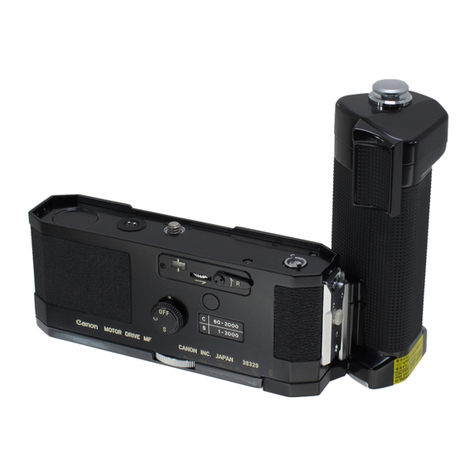
Canon
Canon motor drive mf instruction manual
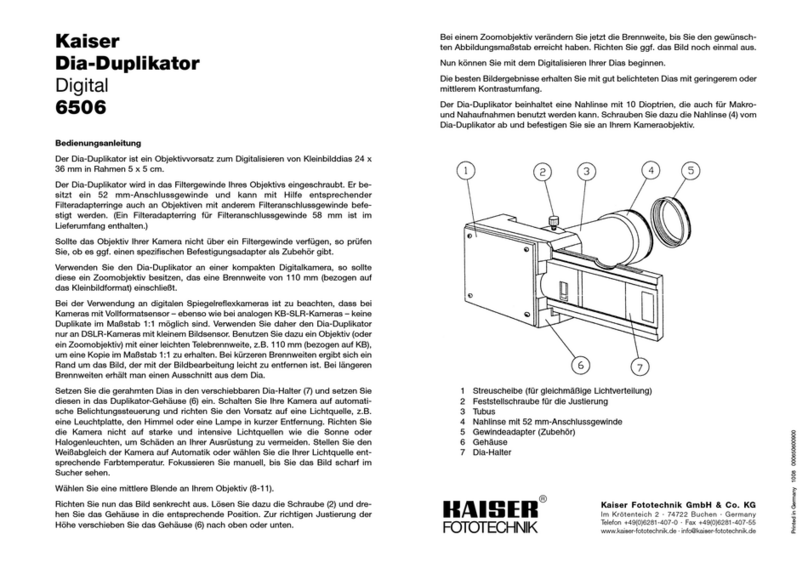
Kaiser
Kaiser 6506 instructions

10 Bar Underwater Housings
10 Bar Underwater Housings 5 D Mark II user manual
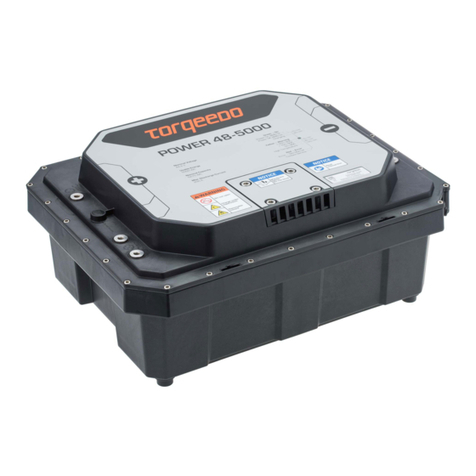
Torqeedo
Torqeedo Power 48-5000 Translation of the original operating instructions

PROAIM
PROAIM VH-OBTR-01 Assembly manual

Nissin
Nissin Di466 instruction manual

